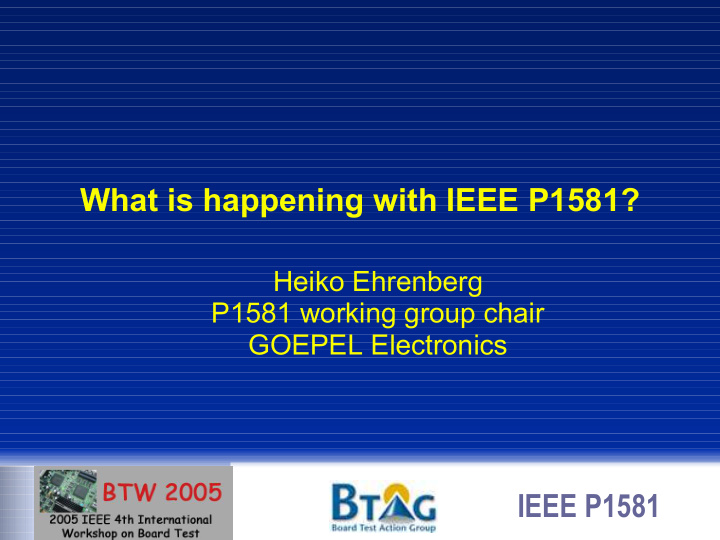



What is happening with IEEE P1581? Heiko Ehrenberg P1581 working group chair GOEPEL Electronics IEEE P1581 What is happening with IEEE P1581? http://grouper.ieee.org/groups/1581/
Purpose “IEEE Std. 1581 will make you forget you ever had a memory problem” Bob Russell What is happening with IEEE P1581? http://grouper.ieee.org/groups/1581/
Outline • Why do we need P1581? • How does P1581 work? • What are possible implementations ? • What is the impact on Board level test? • Current status of development What is happening with IEEE P1581? http://grouper.ieee.org/groups/1581/
• Why do we need P1581? • DDR-SDRAM, DDR2-SDRAM, FLASH, etc. ➔ 1149.1 not built in ! ➔ Controllability ➔ Complexity ➔ Test time ➔ Test conditions (use of untested resources to test the DUT) What is happening with IEEE P1581? http://grouper.ieee.org/groups/1581/
How does P1581 work? Example: memory device PCB IEEE Std. P1581 device Test Pin Test (if no Memory Control TTM) Controller TTM (optional) Memory Cells Micro Input Controller, y bus x or other Combinational host device Test Logic Output bus What is happening with IEEE P1581? http://grouper.ieee.org/groups/1581/
P1581 test logic circuitry • XOR/XNOR, or Inverters/AND • Only combinational, non-sequential logic • Easy to implement, simple test vectors • Faults on pins don't inhibit test of other pins • Fault detection guaranteed • Fault diagnostics depends on implementation, test vectors • Patented vs. public domain What is happening with IEEE P1581? http://grouper.ieee.org/groups/1581/
Entering and leaving Test Mode Test Pin TTM (Transparent Test Mode) • Dedicated test • No dedicated pin enable pin • P1581 mode until • Unconditional test first write mode access • Not usable for certain • Active state defined devices (e.g. FLASH) by chip designer TTM: write access detected Power On Power Off P1581 test mode functional mode outputs = f(inputs) t What is happening with IEEE P1581? http://grouper.ieee.org/groups/1581/
Board level test and P1581 • Simple, quasi-static interconnect test (no need for at-speed access or initialization) • Multiple P1581 devices in bus structure What is happening with IEEE P1581? http://grouper.ieee.org/groups/1581/
Current status of development • Test logic architecture defined; editorial work remains; • Test mode control defined; editorial work remains; • Description language defined • Completed draft expected for early 2006 ➔ Ballot in 2006 What is happening with IEEE P1581? http://grouper.ieee.org/groups/1581/
Conclusion Before P1581: • FLASH device connections not easily testable • Synchronous memory devices may cause test problems Now: • P1581 = an elegant solution • A perfect match for Boundary Scan “IEEE Std. 1581 will make you forget you ever had a memory problem” Bob Russell What is happening with IEEE P1581? http://grouper.ieee.org/groups/1581/
Recommend
More recommend